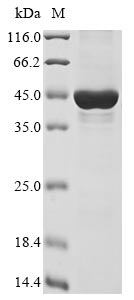In the general process of expressing the recombinant human inactive histone-lysine N-methyltransferase 2E (KMT2E) protein, a plasmid encoding the human KMT2E protein (151-450aa) and the N-terminal 10xHis-tag gene and C-terminal Myc-tag gene is constructed first. The plasmid is transferred into E.coli cells, from which cells containing the plasmid are selected and cultured to express the protein. The recombinant human KMT2E protein undergoes affinity purification and SDS-PAGE analysis. This protein surpasses a purity level of 85%.
KMT2E, also called MLL5, is a protein that helps regulate how DNA is packaged inside cells and is active during different stages of the cell cycle. It's super important for making blood cells and sperm, and keeping the cell cycle running smoothly [1][2]. This protein is a large molecule, made up of 1,858 building blocks called amino acids. It has specific parts at the beginning, including an enzymatic SET domain and a Zn-finger PHD domain, which are important for its function. Even though the SET domain might not be working, KMT2E seems to lack its methyltransferase activity [3][4]. Besides its role in normal cell activities, KMT2E is also involved in brain development and function, and disruptions in its function have been linked to conditions like epilepsy and autism-like traits [5][6]. It's not just important for normal functions—KMT2E is also linked to diseases like prostate cancer and a type of blood cancer called acute promyelocytic leukemia, showing how crucial it is for health and disease [7][8]. One interesting thing about KMT2E is its involvement in sperm production and how it interacts with certain types of genetic material called long non-coding RNAs, which affects how DNA is packaged [9][10]. Plus, it seems to play a role in controlling the body's response to viruses by regulating the expression of certain genes involved in the immune response [11].
References:
[1] L. Spindola, M. Santoro, P. Pan, V. Ota, G. Xavier, C. Carvalhoet al., Detecting multiple differentially methylated cpg sites and regions related to dimensional psychopathology in youths, Clinical Epigenetics, vol. 11, no. 1, 2019. https://doi.org/10.1186/s13148-019-0740-z
[2] Z. Cao, C. Wang, J. Chen, H. Guo, C. Wu, G. Zhanget al., Case report: a novel kmt2e splice site variant as a cause of o'donnell-luria-rodan syndrome in a male patient, Frontiers in Pediatrics, vol. 10, 2022. https://doi.org/10.3389/fped.2022.822096
[3] A. O’Donnell-Luria, L. Pais, V. Faundes, J. Wood, A. Sveden, V. Luriaet al., "Heterozygous variants in kmt2e cause a spectrum of neurodevelopmental disorders and epilepsy, The American Journal of Human Genetics, vol. 104, no. 6, p. 1210-1222, 2019. https://doi.org/10.1016/j.ajhg.2019.03.021
[4] A. O’Donnell-Luria, L. Pais, V. Faundes, J. Wood, A. Sveden, V. Luriaet al., Heterozygous variants in kmt2e cause a spectrum of neurodevelopmental disorders and epilepsy,, 2019. https://doi.org/10.1101/566091
[5] Y. Li, C. Li, c. Li, D. Hu, Z. Xv, S. Zhanget al., Kmt2e haploinsufficiency manifests autistic-like phenotypes and amygdala abnormality in mice,, 2022. https://doi.org/10.21203/rs.3.rs-1464871/v1
[6] P. Panda and I. Sharawat, Clinical characteristics and genotype–phenotype correlation in children with kmt2e gene-related neurodevelopmental disorders: report of two new cases and review of published literature, Neuropediatrics, vol. 52, no. 02, p. 098-104, 2020. https://doi.org/10.1055/s-0040-1715629
[7] Y. Zhang, L. Yan, W. Yao, K. Chen, H. Xu, & Z. Ye, Integrated analysis of genetic abnormalities of the histone lysine methyltransferases in prostate cancer, Medical Science Monitor, vol. 25, p. 193-239, 2019. https://doi.org/10.12659/msm.912294
[8] A. Lucena-Araújo, H. Kim, R. Jácomo, R. Melo, R. Bittencourt, R. Pasqüiniet al., Prognostic impact of kmt2e transcript levels on outcome of patients with acute promyelocytic leukaemia treated with all‐trans retinoic acid and anthracycline‐based chemotherapy: an international consortium on acute promyelocytic leukaemia study, British Journal of Haematology, vol. 166, no. 4, p. 540-549, 2014. https://doi.org/10.1111/bjh.12921
[9] Y. Tai, Allele-specific control of rodent and human lncrna kmt2e-as1 promotes hypoxic endothelial pathology in pulmonary hypertension, Science Translational Medicine, vol. 16, no. 729, 2024. https://doi.org/10.1126/scitranslmed.add2029
[10] I. Khan, H. Liu, J. Zhuang, N. Khan, D. Zhang, J. Chenet al., Circular rna expression and regulation profiling in testicular tissues of immature and mature wandong cattle (bos taurus), Frontiers in Genetics, vol. 12, 2021. https://doi.org/10.3389/fgene.2021.685541
[11] V. Budroni and G. Versteeg, Negative regulation of the innate immune response through proteasomal degradation and deubiquitination, Viruses, vol. 13, no. 4, p. 584, 2021. https://doi.org/10.3390/v13040584






